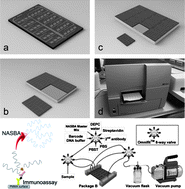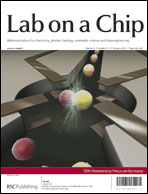Waterborne pathogens usually pose a global threat to animals and human beings. There has been a growing demand for convenient and sensitive tools to detect the potential emerging pathogens in water. In this study, a lab-on-a-chip (LOC) device based on the real-time immuno-NASBA (immuno-nucleic acid sequence-based amplification) assay was designed, fabricated and verified. The disposable immuno-NASBA chip is modelled on a 96-well ELISA microplate, which contains 43 reaction chambers inside the bionic channel networks. All valves are designed outside the chip and are reusable. The sample and reagent solutions were pushed into each chamber in turn, which was controlled by the valve system. Notably, the immuno-NASBA chip is completely compatible with common microplate readers in a biological laboratory, and can distinguish multiple waterborne pathogens in water samples quantitatively and simultaneously. The performance of the LOC device was demonstrated by detecting the presence of a synthetic peptide, ACTH (adrenocorticotropic hormone) and two common waterborne pathogens, Escherichia coli (E. coli) and rotavirus, in artificial samples. The results indicated that the LOC device has the potential to quantify traces of waterborne pathogens at femtomolar levels with high specificity, although the detection process was still subject to some factors, such as ribonuclease (RNase) contamination and non-specific adsorption. As an ultra-sensitive tool to quantify waterborne pathogens, the LOC device can be used to monitor water quality in the drinking water system. Furthermore, a series of compatible high-throughput LOC devices for monitoring waterborne pathogens could be derived from this prototype with the same design idea, which may render the complicated immuno-NASBA assays convenient to common users without special training.

You have access to this article
 Please wait while we load your content...
Something went wrong. Try again?
Please wait while we load your content...
Something went wrong. Try again?


 Please wait while we load your content...
Please wait while we load your content...